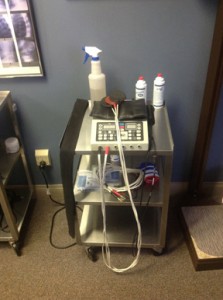Interferential therapy (IFT) is one of various types of physical therapy. It uses a mid-frequency electrical signal to treat muscular spasms and strains. The current produces a massaging effect over the affected area at periodic intervals, and this stimulates the secretion of endorphins, the body’s natural pain relievers, thus relaxing strained muscles and promoting soft-tissue healing. Its use is contraindicated if the affected area has wounds, cuts or infections.
The basic principle of IFT is to use physiological effects of low frequency (at <250 pps) electrical stimulation of nerves without the associated painful and somewhat unpleasant side effects sometimes associated with low-frequency stimulation.
It has been suggested that IFT works in a ‘special way’ because it is ‘interferential’ as opposed to ‘normal’ stimulation. The evidence for this special effect is lacking, and it is most likely that IFT is just another means of stimulating peripheral nerves. It is rather a generic means of stimulation. The machine can be set up to act more like a TENS-type device or a muscle stimulator by adjusting the stimulating (beat) frequency. Some patients regard it as more acceptable, as it generates less discomfort than some other forms of electrical stimulation.
IFT is used in four clinical applications, to:
- Relieve pain
- Stimulate muscles
- Increase local blood flow
- Reduce edema
Proponents make additional claims for its role in stimulating healing and repair, and for various specialized application, such as stress and incontinence. For healing and repair, there is a dearth of quality research available.
As IFT acts primarily on the excitable (nerve) tissues, the strongest effects are likely to result from such stimulation—that is, pain relief and muscle stimulation. Other effects are likely to be secondary consequences of these.

